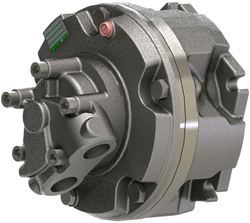Products
Hydraulic Motors
Hydraulic motor is used to transform hydraulic fluid energy into mechanical energy (electrical motor rotating shaft). In order to generate enough torque and rotation of shaft, hydraulic pressure and flow is required.
You can use hydraulic motors for many applications, such as winches, crane drives, self-driven cranes, excavators, mixer and agitator drives, roll mills, etc.
Uses of hydraulic motors as follows:
- Rolling mills
- Concrete mixers
- Winches
- Crane drive
- Manual (self driven) cranes
- Excavators
- Agitator drives
Hydraulic pump and motors have very similar designs. Therefore, some of the fixed displacement pumps can also be used as hydraulic motors.
Different types of hydraulic motors as follows:
Hydraulic gear motors:
- Hydraulic gear motor
- Epicyclic gear motor


Hydraulic vane motors:
- Balanced vane motor

Hydraulic piston motors:
- Axial piston type hydraulic motor
- Radial piston type hydraulic motor

The power produced by a hydraulic motor is determined by the flow and pressure drop of the motor. The displacement and pressure drop of the motor determines the torque it generates. The power output is thus directly proportional to the speed. The motors range from high speed motors of up to 10,000 rpm to low speed motors with a minimum of 0.5 rpm.
The power of hydraulic motors can easily be calculated by the pressure drop and flow of motor. Also, the torque can be calculated by the displacement and pressure drop of the hydraulic motor.
Note that low speed hydraulic motors are designed in such a way that large torques are generated at low speeds. High speed motors have better operational characteristics at speeds that are at least higher than 500 rpm.
Higher torque is generated in lower speeds because they are designed to produce larger torques. In fact, higher speed hydraulic motors have improved operational attributes, speeds atleast higher than 500 rpm.
